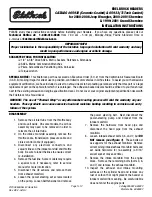
If your vehicle has dual
rear wheels and the
tread design for the front
tires is different from
the dual rear tires,
always use the correct
rotation pattern
shown here when
rotating the tires.
The dual tires are rotated as a pair, and the inside
rear tires become the outside rear tires.
When you install dual wheels, be sure the vent
holes in the inner and outer wheels on each side
are lined up.
After the tires have been rotated, adjust the
front and rear inflation pressures as shown
on the Tire and Loading Information label.
See
Inflation - Tire Pressure on page 5-76
and
Loading Your Vehicle on page 4-36
.
Make certain that all wheel nuts are properly
tightened. See “Wheel Nut Torque” under
Capacities and Specifications on page 5-133
.
{
CAUTION:
Rust or dirt on a wheel, or on the parts to
which it is fastened, can make wheel nuts
become loose after time. The wheel could
come off and cause an accident. When
you change a wheel, remove any rust or
dirt from places where the wheel attaches
to the vehicle. In an emergency, you can
use a cloth or a paper towel to do this;
but be sure to use a scraper or wire brush
later, if needed, to get all the rust or dirt
off. See
Changing a Flat Tire on page 5-94
.
If your vehicle has a Tire Pressure Monitor
System (TPMS), reset the TPMS sensors after
rotating the tires. See
Tire Pressure Monitor
Operation on page 5-79
.
Make sure the spare tire, if your vehicle has one,
is stored securely. Push, pull, and then try to
rotate or turn the tire. If it moves, tighten the cable.
See
Storing a Flat or Spare Tire and Tools on
page 5-110
.
5-85
Summary of Contents for 2008 Silverado 1500 Pickup
Page 20: ...Put someone on it Get it up to speed Then stop the vehicle The rider does not stop 1 16 ...
Page 94: ... NOTES 1 90 ...
Page 178: ... NOTES 2 84 ...
Page 181: ... NOTES 3 3 ...
Page 406: ... NOTES 4 94 ...
Page 542: ... NOTES 5 136 ...
















































